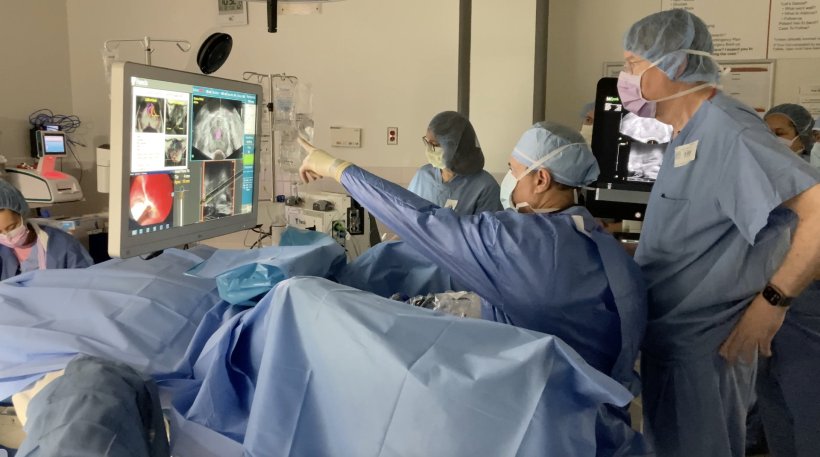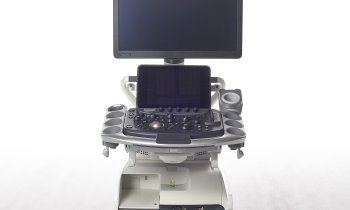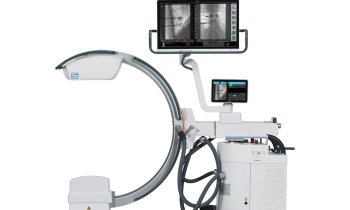
Image source: Keck Medicine; photo: Jessica Reynolds
News • Catheter-based approach
New method aims to "steam away" prostate cancer
A clinical trial offered by Keck Medicine of USC uses steam rather than surgery or radiation to potentially destroy cancer cells for certain prostate cancer patients.
Steam eliminates wrinkles and germs, but can it destroy cancer cells too? Keck Medicine of the University of Southern California (USC) is participating in a national, multisite clinical trial examining if a water vapor system that uses small, targeted amounts of steam to kill cancer cells is a safe and effective treatment for prostate cancer.
Researchers hope that steam may offer patients a less invasive way of controlling or curing cancer than currently exists. “The most common therapies for prostate cancer often cause life-altering side effects, and we are investigating if this new treatment may not only treat the cancer, but offer our patients overall better quality-of-life outcomes,” said Andre Abreu, MD, a Keck Medicine urologist and lead investigator of the Keck Medicine clinical trial site. Abreu also leads focal therapy and artificial intelligence efforts for prostate cancer with USC Urology.
Recommended article

Article • Research, diagnostics, therapy
Focus on prostate cancer
Prostate cancer (PCa) is not only one of the most common, but also one of the deadliest types of cancer in men. Diagnostics are correspondingly sophisticated, from imaging via ultrasound or MRI to various biopsy techniques – often even in combination. Keep reading for current developments in early detection, staging, therapy and research.
The clinical trial is designed for patients with intermediate-risk prostate cancer, meaning that the tumor is localized in the prostate gland and has not spread to other organs. This type of cancer accounts for approximately one-third of all localized prostate cancers, according to Abreu.
Some patients with prostate cancer may not need any treatment if the cancer is small enough and slow growing. However, when treatment is necessary, traditionally, physicians have treated patients with either surgery or radiation. These techniques are generally effective in treating the cancer, however, there can be side effects. The prostate is located in between the bladder, the urethra (a duct that transports urine from the bladder) and the rectum. It is surrounded by numerous nerves responsible for penile erections and the muscle that controls urine flow, the urinary sphincter. During surgery or radiation, there is a risk of injuring healthy tissue along with the cancer and damaging the delicate structures that lie next to the prostate.
This procedure is thought to be much gentler on the body than traditional therapies and is designed to target the cancerous tissue within the prostate
Andre Abreu
The most common side effects of surgery and radiation are impotence, urinary incontinency and bowel dysfunction. “While patients are happy to be free of cancer, the costs of the cure are very high,” said Abreu. “There is a growing amount of literature in the field suggesting that select patients could benefit from a procedure with fewer risks that allows them to maintain their quality of life after cancer.”
Heat is one therapy to help damage and kill cancer cells, according to the National Cancer Institute. Steam offers a targeted way to deliver heat into the body, according to Abreu. Before the procedure, physicians use magnetic resonance imaging (MRI) to locate the tumor cells in the patient’s prostate. During the procedure, doctors use an ultrasound and prostate mapping to guide a thin catheter through the patient’s urethra and into the area of the prostate where the tumor is located. Once the catheter is positioned, a fine needle is deployed in the tumor. Doctors then release a quick, targeted 10-second burst of steam from the needle, and more bursts as needed, to destroy the tumor. “This procedure is thought to be much gentler on the body than traditional therapies and is designed to target the cancerous tissue within the prostate,” said Abreu. “We are exploring if steam may be effective at destroying cancer cells without damaging the surrounding organs.”
Another potential advantage to the investigational therapy is that unlike surgery, which requires an overnight stay in the hospital, the water vapor therapy is an outpatient procedure. And unlike radiation, which usually involves multiple sessions, the water vapor therapy is designed to work using only one application.
The clinical trial is being conducted at up to 30 hospitals and health centers across the nation. So far, more than 180 procedures have been completed. Keck Hospital of USC is the only Los Angeles area site participating in the study. Patients’ post-treatment cancer outcomes will be followed for five years. The study is sponsored by Francis Medical, Inc., a privately held medical company that developed the device being used, the Vanquish Water Vapor Ablation System.
The water vapor ablation system is one of several minimally invasive treatments for prostate cancer either already in use or being developed within the field of urology. “Over the next decade or so, we hope to see innovative therapies revolutionize how we help patients become cancer-free while maintaining their quality of life,” said Abreu.
Dr. Abreu declares no conflict of interest with the sponsor.
Source: Keck Medicine of USC
16.01.2025











